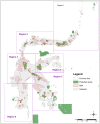A bolder conservation future for Indonesia by prioritising biodiversity, carbon and unique ecosystems in Sulawesi
- PMID: 36646696
- PMCID: PMC9842766
- DOI: 10.1038/s41598-022-21536-2
A bolder conservation future for Indonesia by prioritising biodiversity, carbon and unique ecosystems in Sulawesi
Abstract
As more ambitious protected area (PA) targets for the post-2020 global biodiversity framework are set beyond Aichi Target 11, renew thinking into spatial prioritisation is required to enable PA expansion that maximises environmental values. Our study focuses on the biodiverse and forest-rich Indonesian island of Sulawesi, which has a terrestrial PA network that covers 10% of the island. We used Marxan to investigate trade-offs in the design of an expanded PA network that prioritised different conservation features (biodiversity, forest cover, carbon stock, karst and valuable metal-rich areas) under varying island-wide coverage targets (17%, 30%, and 50%). Our first scenario, which required existing PAs to be selected, required larger areas to meet these coverage targets, in contrast to our second scenario, which allowed for any part of the island to be chosen, irrespective of PA status. The vast Mekongga and Bangkiriang Landscapes, and Gorontalo corridor were consistently identified as a high priority for protection under all scenarios. To meet our conservation targets through expanding current PAs, creating new PAs, and creating corridors that connect existing PAs, we used a spatially explicit three-phase approach. Our findings identified 26,508 km2 of priority areas to be included in the current PA network, potentially assisting Indonesia in meeting its post-2020 GBF target, if our approach is replicated across Indonesia as a national or sub-national analysis. We discuss various land management options through other effective area-based conservation measures (OECMs) and the costs to deliver this strategy.
© 2023. The Author(s).
Conflict of interest statement
The authors declare no competing interests.
Figures





Similar articles
-
Evaluating and expanding the European Union's protected-area network toward potential post-2020 coverage targets.Conserv Biol. 2020 Jun;34(3):654-665. doi: 10.1111/cobi.13479. Epub 2020 Mar 23. Conserv Biol. 2020. PMID: 32022301
-
Bolder science needed now for protected areas.Conserv Biol. 2016 Apr;30(2):243-8. doi: 10.1111/cobi.12645. Epub 2016 Jan 14. Conserv Biol. 2016. PMID: 26486683
-
Synergies and trade-offs in achieving global biodiversity targets.Conserv Biol. 2016 Feb;30(1):189-95. doi: 10.1111/cobi.12559. Epub 2015 Aug 6. Conserv Biol. 2016. PMID: 26041135
-
Making protected areas effective for biodiversity, climate and food.Glob Chang Biol. 2023 Jul;29(14):3883-3894. doi: 10.1111/gcb.16664. Epub 2023 Mar 21. Glob Chang Biol. 2023. PMID: 36872638 Review.
-
Protected areas in South Asia: Status and prospects.Sci Total Environ. 2022 Mar 10;811:152316. doi: 10.1016/j.scitotenv.2021.152316. Epub 2021 Dec 13. Sci Total Environ. 2022. PMID: 34915005 Review.
Cited by
-
Conservation status assessments of species-rich tropical taxa in the face of data availability limitations: insights from Sulawesi Begonia.Sci Rep. 2024 Jun 18;14(1):14007. doi: 10.1038/s41598-024-64319-7. Sci Rep. 2024. PMID: 38890332 Free PMC article.
References
-
- Jepson PR, et al. Protected area asset stewardship. Biol. Conserv. 2017;212:183–190. doi: 10.1016/j.biocon.2017.03.032. - DOI
-
- Tyrrell P, du Toit JT, Macdonald DW. Conservation beyond protected areas: Using vertebrate species ranges and biodiversity importance scores to inform policy for an East African country in transition. Conserv. Sci. Pract. 2019 doi: 10.1111/csp2.136. - DOI
-
- Gaveau DLA, et al. Evaluating whether protected areas reduce tropical deforestation in Sumatra. J. Biogeogr. 2009;36:2165–2175. doi: 10.1111/j.1365-2699.2009.02147.x. - DOI
Publication types
MeSH terms
LinkOut - more resources
Full Text Sources
Research Materials


